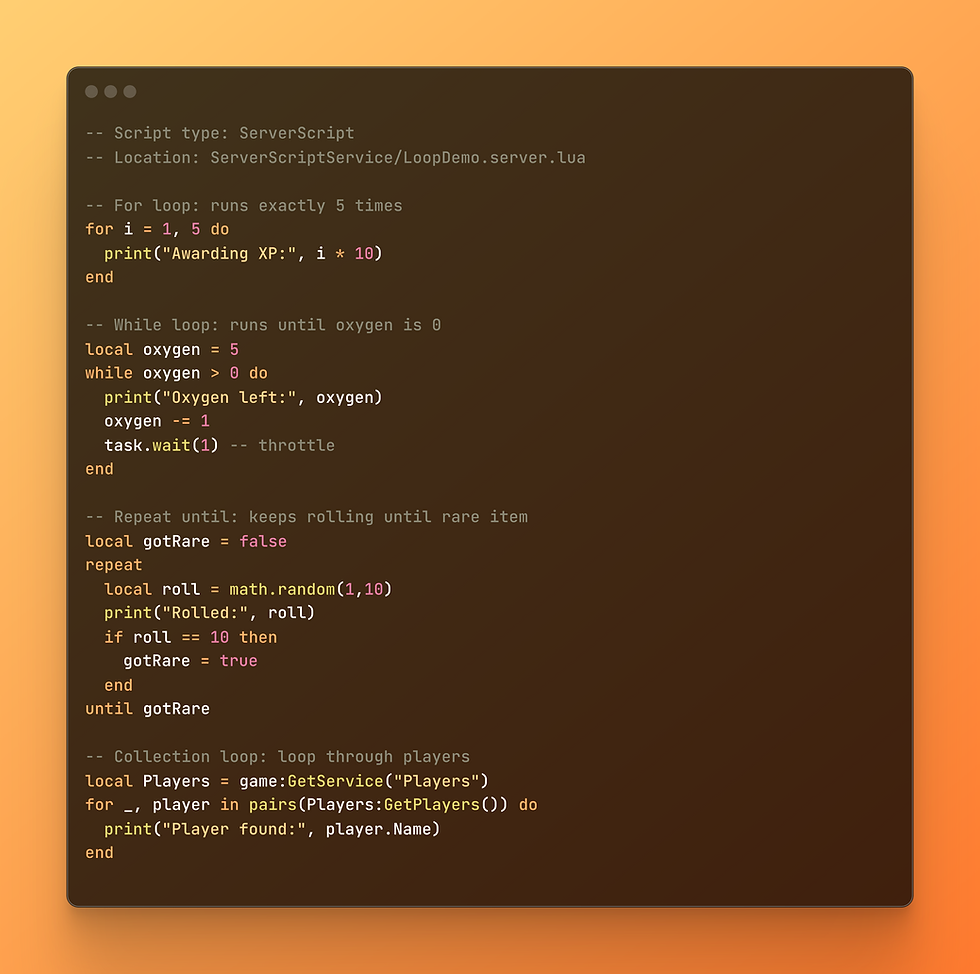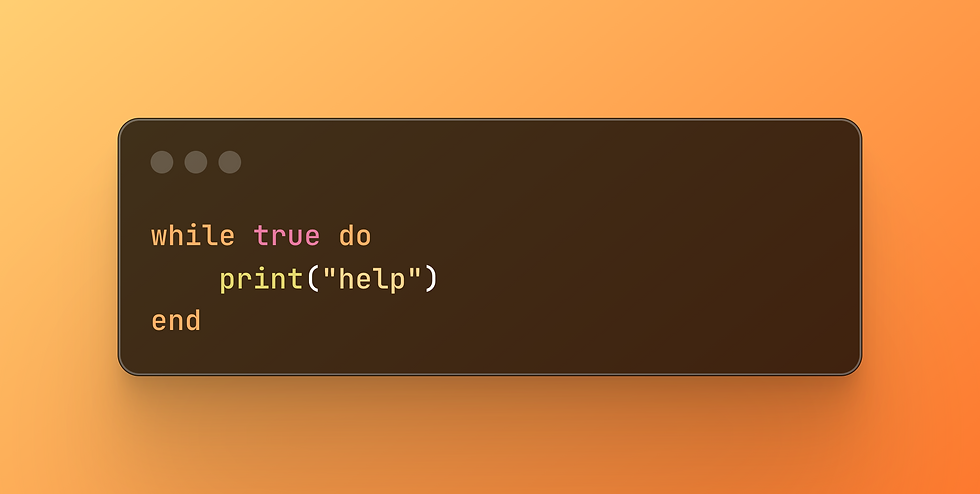Roblox Loops: How to Repeat Smarter, Not Harder
- Primal Cam
- Aug 16
- 4 min read
If functions are the verbs of Roblox scripting, then loops are the heartbeat. They’re what make your game tick—literally. Loops keep coins spinning, timers counting, enemies moving, and your entire game world alive.
But let’s be honest: loops are also one of the easiest ways to accidentally crash your game. A poorly written loop can freeze the client, melt the server, or send your FPS into single digits. So today, we’ll break down Roblox loops—how they work, when to use them, and how to keep them efficient.
By the end, you’ll see loops not as scary infinite whirlpools, but as reliable engines that drive gameplay forward.
Why Loops Matter in Roblox
Think of any repeating action in your game:
A coin that spins endlessly.
A timer counting down.
A player’s oxygen bar draining second by second.
NPCs patrolling until the player comes close.
All of those rely on loops. Without them, your world is frozen in time.
Loops let you do something over and over without copying code. Instead of writing “spin coin” a hundred times, you write it once inside a loop and let Roblox handle the repetition.
The Core Types of Loops in Roblox
There are only a few, but they cover almost everything you need:
1. for Loops
Great for when you know exactly how many times you want something to repeat.
Example use: Awarding XP for each of 10 completed stages.
They’re predictable and safe—hard to mess up.
2. while Loops
Perfect for when you want to keep going until a condition changes.
Example use: Keep draining oxygen while the player is underwater.
Just make sure your condition eventually becomes false, or you’ve got an infinite loop.
3. repeat until Loops
These are cousins of while loops but run at least once before checking.
Example use: Keep rolling loot until the player gets a rare item.
Guaranteed to execute at least once, no matter what.
4. Collection Loops (pairs, ipairs)
Used to loop through tables or object containers.
Example use: Loop through every spawn point and place a piggy bank.
Essential when working with arrays or dictionaries in your ModuleScripts.
The Golden Rule of Loops: Efficiency
Here’s what separates beginners from pros: knowing how to loop without breaking performance.
Loops are deceptively expensive. One careless infinite loop can freeze Studio. A server-side loop that updates every frame can lag out 50 players at once.
So how do you keep loops efficient?
Throttle them. Use task.wait() inside while loops to prevent them from running millions of times per second.
Scope them. Only loop what you need. Don’t loop through every single part in Workspace if you only care about props tagged “Smashable.”
Kill them cleanly. Always give your loop an exit condition. If the player leaves the game, their loop should stop.
One Clean Example (All in One Place)
Here’s the single example for this article, showing each type of loop in one script. You don’t need 20 snippets—you just need one clear demo you can reference again and again:

Real Game Use Cases
Let’s make this practical. Here’s where each type shines in real development:
For loop: Level up animation that scales 10 times, or a cutscene sequence that runs step by step.
While loop: Hunger or stamina bar draining over time.
Repeat until loop: Fishing system—keep casting until you get a fish.
Collection loop: Equipping perks for all pets in the player’s inventory.
The Pitfalls Beginners Make
Every new dev eventually runs into one of these:
Infinite Loops Without Throttles

This will lock Studio instantly. Always add task.wait().
Looping Over Too Much DataLooping through every part in Workspace when you only need tagged objects is wasteful. Use CollectionService instead.
Client vs Server ConfusionA while loop on the client only affects that one player. A server loop runs for all players and is much heavier. Know where your loop lives.
Loops + Events = Perfection
The real secret isn’t using loops alone—it’s combining them with events.
Example: Instead of looping forever to check “is player underwater?”, connect to the Touched event of a water part. Start the loop when they enter, stop it when they leave. This hybrid approach is lighter, smarter, and scales better.
A Pro Checklist for Loops
Did you add a throttle (task.wait())?
Does your loop have an exit condition?
Are you looping over the smallest data set possible?
Did you test with multiple players to see server impact?
Can an event replace or control this loop?
If you can check all five, your loop is production-ready.
Closing Thought | Roblox loops
Loops are the pulse of your Roblox game. They’re simple at first glance, but mastering when and how to use them separates a messy script from a professional system.
So next time you drop into Studio, ask yourself: Does this really need a loop? Or can I combine it with events, conditions, and smart throttling to make it efficient?
Your players will never know the difference—but your FPS will thank you.
Would you like me to also write the focus keyword + meta description for SEO like we did for the Functions article?

$50
Product Title
Product Details goes here with the simple product description and more information can be seen by clicking the see more button. Product Details goes here with the simple product description and more information can be seen by clicking the see more button

$50
Product Title
Product Details goes here with the simple product description and more information can be seen by clicking the see more button. Product Details goes here with the simple product description and more information can be seen by clicking the see more button.

$50
Product Title
Product Details goes here with the simple product description and more information can be seen by clicking the see more button. Product Details goes here with the simple product description and more information can be seen by clicking the see more button.




Comments